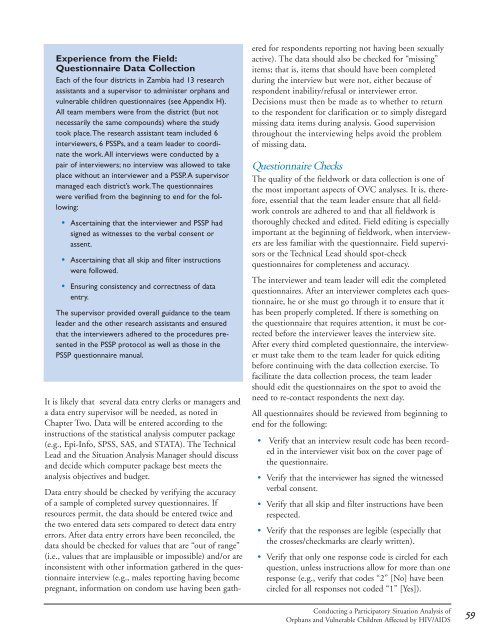Conducting a Participatory Situation Analysis of.pdf - Global HIV ...
Conducting a Participatory Situation Analysis of.pdf - Global HIV ...
Conducting a Participatory Situation Analysis of.pdf - Global HIV ...
Create successful ePaper yourself
Turn your PDF publications into a flip-book with our unique Google optimized e-Paper software.
Experience from the Field:<br />
Questionnaire Data Collection<br />
Each <strong>of</strong> the four districts in Zambia had 13 research<br />
assistants and a supervisor to administer orphans and<br />
vulnerable children questionnaires (see Appendix H).<br />
All team members were from the district (but not<br />
necessarily the same compounds) where the study<br />
took place.The research assistant team included 6<br />
interviewers, 6 PSSPs, and a team leader to coordinate<br />
the work.All interviews were conducted by a<br />
pair <strong>of</strong> interviewers; no interview was allowed to take<br />
place without an interviewer and a PSSP.A supervisor<br />
managed each district’s work.The questionnaires<br />
were verified from the beginning to end for the following:<br />
• Ascertaining that the interviewer and PSSP had<br />
signed as witnesses to the verbal consent or<br />
assent.<br />
• Ascertaining that all skip and filter instructions<br />
were followed.<br />
• Ensuring consistency and correctness <strong>of</strong> data<br />
entry.<br />
The supervisor provided overall guidance to the team<br />
leader and the other research assistants and ensured<br />
that the interviewers adhered to the procedures presented<br />
in the PSSP protocol as well as those in the<br />
PSSP questionnaire manual.<br />
It is likely that several data entry clerks or managers and<br />
a data entry supervisor will be needed, as noted in<br />
Chapter Two. Data will be entered according to the<br />
instructions <strong>of</strong> the statistical analysis computer package<br />
(e.g., Epi-Info, SPSS, SAS, and STATA). The Technical<br />
Lead and the <strong>Situation</strong> <strong>Analysis</strong> Manager should discuss<br />
and decide which computer package best meets the<br />
analysis objectives and budget.<br />
Data entry should be checked by verifying the accuracy<br />
<strong>of</strong> a sample <strong>of</strong> completed survey questionnaires. If<br />
resources permit, the data should be entered twice and<br />
the two entered data sets compared to detect data entry<br />
errors. After data entry errors have been reconciled, the<br />
data should be checked for values that are “out <strong>of</strong> range”<br />
(i.e., values that are implausible or impossible) and/or are<br />
inconsistent with other information gathered in the questionnaire<br />
interview (e.g., males reporting having become<br />
pregnant, information on condom use having been gathered<br />
for respondents reporting not having been sexually<br />
active). The data should also be checked for “missing”<br />
items; that is, items that should have been completed<br />
during the interview but were not, either because <strong>of</strong><br />
respondent inability/refusal or interviewer error.<br />
Decisions must then be made as to whether to return<br />
to the respondent for clarification or to simply disregard<br />
missing data items during analysis. Good supervision<br />
throughout the interviewing helps avoid the problem<br />
<strong>of</strong> missing data.<br />
Questionnaire Checks<br />
The quality <strong>of</strong> the fieldwork or data collection is one <strong>of</strong><br />
the most important aspects <strong>of</strong> OVC analyses. It is, therefore,<br />
essential that the team leader ensure that all fieldwork<br />
controls are adhered to and that all fieldwork is<br />
thoroughly checked and edited. Field editing is especially<br />
important at the beginning <strong>of</strong> fieldwork, when interviewers<br />
are less familiar with the questionnaire. Field supervisors<br />
or the Technical Lead should spot-check<br />
questionnaires for completeness and accuracy.<br />
The interviewer and team leader will edit the completed<br />
questionnaires. After an interviewer completes each questionnaire,<br />
he or she must go through it to ensure that it<br />
has been properly completed. If there is something on<br />
the questionnaire that requires attention, it must be corrected<br />
before the interviewer leaves the interview site.<br />
After every third completed questionnaire, the interviewer<br />
must take them to the team leader for quick editing<br />
before continuing with the data collection exercise. To<br />
facilitate the data collection process, the team leader<br />
should edit the questionnaires on the spot to avoid the<br />
need to re-contact respondents the next day.<br />
All questionnaires should be reviewed from beginning to<br />
end for the following:<br />
• Verify that an interview result code has been recorded<br />
in the interviewer visit box on the cover page <strong>of</strong><br />
the questionnaire.<br />
• Verify that the interviewer has signed the witnessed<br />
verbal consent.<br />
• Verify that all skip and filter instructions have been<br />
respected.<br />
• Verify that the responses are legible (especially that<br />
the crosses/checkmarks are clearly written).<br />
• Verify that only one response code is circled for each<br />
question, unless instructions allow for more than one<br />
response (e.g., verify that codes “2” [No] have been<br />
circled for all responses not coded “1” [Yes]).<br />
<strong>Conducting</strong> a <strong>Participatory</strong> <strong>Situation</strong> <strong>Analysis</strong> <strong>of</strong><br />
Orphans and Vulnerable Children Affected by <strong>HIV</strong>/AIDS<br />
59















